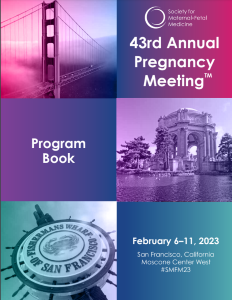Category: Diabetes
Poster Session II
(622) What is the implication of a HbBA1C ≥5.7% in patients with gestational diabetes?
Hemoglobin A1c (HbA1c) of ≥5.7% signifies impaired glucose regulation, however data is limited regarding its prognostic utility in patients with gestational diabetes mellitus (GDM) during and after pregnancy. In our Diabetes in Pregnancy Program, HbA1c is sent at diagnosis of GDM after 24 weeks. We compared patients with HbA1c < 5.7% to those with ≥5.7% regarding demographics, need for medication in pregnancy, and persistence of impaired glucose tolerance postpartum.
Study Design: IRB approved retrospective cohort study of patients diagnosed with GDM at 24+ weeks from 2016-2020. Patients with HbA1c < 5.7% were compared to those with ≥5.7%. Age, BMI, race, GTT values, history of thyroid disease, PCOS, IVF, previous GDM, family history of diabetes, need for medication, and postpartum diagnosis of impaired glucose tolerance or diabetes were compared. Odds ratios were calculated to assess likelihood of needing medication in pregnancy and impaired glucose tolerance postpartum with HbA1c ≥5.7%.
Results: There were 405 patients with GDM. HbA1c ranged from 4.4% to 7.8% (median=5.1%). 88% had HbA1c < 5.7% while 12% had ≥5.7%. More Black and Hispanic patients had HbA1c≥5.7% while more Asian patients had HbA1c< 5.7% (p < 0.01). Those with HbA1c≥5.7% had higher BMI (p < 0.01) and higher GTT values (p < 0.05, Table 1). A greater proportion of patients with HbA1c≥5.7% required medication compared to HbA1c < 5.7% (77% vs 38%, OR 5.5 p< 0.01, Table 2). 20% of patients with GDM underwent diabetes screening postpartum. Screening rates were similar between groups; 7% of patients with HbA1c < 5.7% in pregnancy had postpartum diabetes or impaired glucose compared to 78% of patients with HbA1c≥5.7% in pregnancy (OR 74, p< 0.01).
Conclusion:
Our data suggests that patients with GDM and HbA1c of ≥5.7% are 5 times as likely to need medication in pregnancy and are 74 times as likely to be diagnosed with impaired glucose or diabetes postpartum. Future initiatives should target postpartum screening in GDM patients with HbA1c ≥5.7%, due to the significant risk of impaired glucose regulation with its known health implications.

Tirtza Spiegel Strauss, MD
Fellow
Mount Sinai West, Icahn School of Medicine at Mount Sinai
New York, New York, United States- EM
Emily S. Markovic, MD
OBGYN Resident
Mount Sinai West, Icahn School of Medicine at Mount Sinai
New York, New York, United States - SS
Sophia Scarpelli-Shchur, RN, CDE, RN
Icahn School of Medicine at Mount Sinai
New York, New York, United States - OG
Olivia Grubman, MD, MPH
Icahn School of Medicine at Mount Sinai
New York, New York, United States 
Thomas Owens, MD
Dr Thomas Owens
University of Illinois at Chicago
Chicago, Illinois, United States- GS
Guillaume Stoffels, PhD
Statistician
Icahn School of Medicine at Mount Sinai
New York, New York, United States - DC
David Cole, MD
Mt. Sinai West
New York, New York, United States - GA
Graham Ashmead, MD
Roosevelt Hospital
New York, New York, United States 
Farrah N. Hussain, MD
Assistant Professor
Icahn School of Medicine at Mount Sinai
New York, New York, United States- ZA
Zainab Al-Ibraheemi, MD
Icahn School of Medicine at Mount Sinai
New York, New York, United States - LB
Lois Brustman, MD
St. Luke's Roosevelt Hospital Center
New York, New York, United States

.png)
